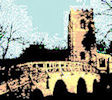Medbourne School History
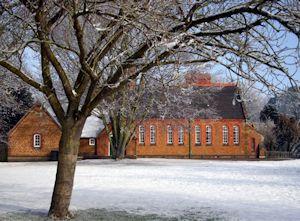
Old Village School now the Village Hall
Contents
- Early Days
- Initial Inspection Problems
- Ownership
- Log Books
- Improvements
- Early Curriculum
- Funding
- Changing Times
- Final Years
- Head Teachers
Early Days
A major renovation was completed in the 17th Century to the Village Church and it was then that the North transept became a schoolroom and a clerestory added to the nave. Even though the Archdeacon ordered the removal of the school in 1777 it remained in the church until 1869 when a new school was opened.
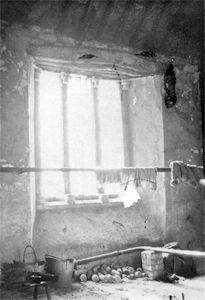
School Room inside Church, 1927
The Enclosure Award of 1844 alloted land to the Rector the Reverend. L.P. Baker (not to the Church) and during the years 1868 and 1869 he arranged the building of a school and master's house on the ground and gave them to the village. The buildings were described as "gabled ironstone buildings in the Gothic style, with red and blue brick dressings". The school opened on the 24th May 1869 and the children moved from the school previously held in the Church. Mr Richard Harrison the Head Master of the Church School, where he had already taught for fourteen years became the first Head Teacher of the new Village School.
In 1870 an Education Act set up School Boards to oversee education and each school which met required standards was called upon to keep a Log Book detailing day to day activities. The first such book in Medbourne was begun in 1872 by Mr. Harrison. Straightway the local School Board objected to the way the school had been conveyed to the village and the Charity Commission was called upon to draw up a Trust Deed which formed the basis of the school management.
Initial Inspection Problems
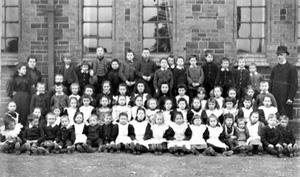
Early Pupils
Government Inspectors visited the school in the early days and refused to grant Mr. Harrison a certificate, or the school a grant because the school was not in a fit condition. More equipment in the form of desks and more apparatus such as maps and pictures were required, along with separate toilets for boys and girls. The latter were to have sufficient space between them to deaden the sound (!) and were to have a dry earth system.
The local authority held funds from the sale of public buildings in Medbourne and eventually permission was given for these to be used to improve the school. The Rector, as Chairman of the Trustees, promised the local School Board that the necessary improvements would be carried out and as a result Mr. Harrison was duly awarded his certificate and a parliamentary grant was awarded to the school. Medbourne School was now officially on its way.
Ownership
Throughout all future developments at the school, including the enlargement in 1912, the Church took no part in providing funds. It seems clear that the intentions of all concerned were that the school should belong to the village and not the Church. Subsequent Education Acts and the fact that in the early days the Rector was the Chairman of the School Trustees, conspired to confuse the issue of "ownership" But in later years, when so many village schools closed as educational establishments, the late Lord Denning established a legal precedent which ruled that buildings given to the village, belonged to the village and not the Church.
Log Books
As mentioned, back in 1872 Mr Harrison the School Master began the first log book and two such books record events through to the closing of the school in 1981. (There is a separate page School logs that contains a detailed year-by-year selection of information from the logs.) The early book (to 1905) shows an obsession with attendance and this was partly because fees were charged. From 13th May 1872 the charges per child , per week were :- Farmers and Land Owners, nine pennies - Tradesman, four pennies - Work People, one penny. The introduction of fees caused great disquiet since until then the Free School in the Church had operated at no cost to Medbourne residents and as a result children were kept away from the school in protest.
From 1872 to 1905 there were usually about eighty children on the roll but the average daily attendance was often around forty. Children were kept away from school to work in the fields and allotments all the year round, making one wonder what they did in winter, perhaps stone picking ? Sickness was another reason for absence and the dreaded fever is mentioned frequently and in 1892 the school was closed for eleven weeks and fumigated.
The school began with children of six to twelve years of age, but following the enlargement in 1912 the ages ranged from four to thirteen years. From 1929 onwards children over the age of eleven attended Hanbury School in Church Langton and Medbourne was designated an Infant and Junior School with pupils aged between four and eleven years. Regulations drawn up in 1944 made the primary school age five to eleven years and the school followed this pattern until it was closed.
Improvements
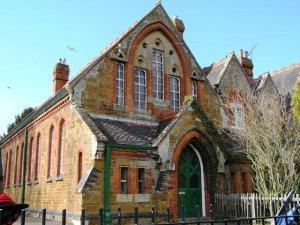
Old School front elevation
The school opened with earth closets, but much later these were upgraded to water closets flushed with buckets of well water and eventually piped water arrived in the 1950's. The luxury of indoor toilets and a staff toilet only arrived with the extension built in 1972. Several attempts were made to heat the school adequately, starting with open coal fires (choking smoke closed the school on one occasion !), then closed stoves and finally semi-automatic oil stoves. Lowering the ceiling in the large room also helped considerably.
Early Curriculum
On the academic front an actual school exercise book of 1856 in the name of Henry Orton at the Free School and the two Log Books give evidence of the development of the education which the children received. The Free School aimed to instruct children in what was then considered to be basic skills, such as handwriting, spelling, grammar and arithmetic. Rote learning with copying from the blackboard was standard practice. Understanding was left to chance and children were told they would understand when they grew up. Enjoyment was irrelevant and probably looked upon as a sign of weakness on the part of the teacher if it ever occurred.
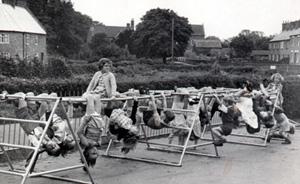
Playtime at School
Between 1872 and 1920 sewing, in the form of making useful items, was particularly important with the grant being withheld on one occasion due to a poor standard of achievement. Physical Education was termed "drill" which fitted the philosophy of "don't think for yourself, just do as you are told". Annual tests on Bible knowledge also figured highly. Holidays were partly geared to harvesting, with potatoes, blackberries and horse chestnuts being mentioned frequently.
Funding
Prior to 1902 Inspectors visited the school annually and the schools finance's depended on good reports - payments by results. The staff of the school consisted of a Master, certificated teachers, assistant teachers, monitors and none of these had received any formal training. With one hundred children on the roll and the constant coming and going of pupils staff duties were largely supervisory. In 1882 one hundred and six children were admitted and one hundred and seven left. The Master frequently complained about "railway children" being ill-disciplined and never staying long enough for their own good or that of the school.
From 1902, when an Education Act made funding more secure the school became more stable, but little changed in the children's education. Scholarships to Harborough Grammar School could be won but few achieved this goal.
Changing Times
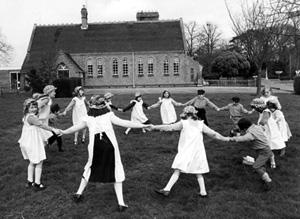
Last Day at School
The 1944 Education Act (Secondary education for all to the age of fourteen, but also the dreaded 11+), coupled with the end of the Second World War brought the beginning of a rapid change. Child-centred methods of teaching came in and interest became the motivation rather than the fear of the cane. Medbourne School was typical of primary schools of this time with pupils work displayed, lots of bright interesting books, music and creative crafts. The school brass band toured the village at Christmas on a lorry, playing carols. Parents were invited to take part in many school activities and Medbourne School became community based and a happy place for children.
The Final Years
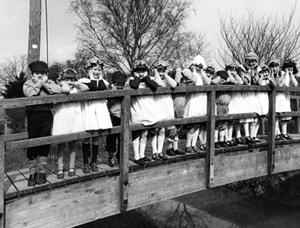
Children in Victorian dress posed on the bridge
Despite the building improvements made over the years and the happy school environment, by 1980 the school roll had fallen to fifteen pupils and the Local Education Authority deemed this not viable as an economic unit and undesirable educationally. The staff was reduced to one teacher – Mrs Jean Clarke – and prepared for closure. In spite of a vigorous campaign mounted in the village to save the school the end came in April 1981 when the school was closed and the children of primary school age were transferred to Bringhurst School. On the last day at the School the children dressed in Victorian costumes (See photos).
Following the closure, the school building was initially referred to as The Old School Centre, but after the sale of the "old" Village Hall for commercial development, was renamed Medbourne Village Hall. It is run by a Management Committee, remains an extremely important asset in the community and is a focal point for many activities in the village.
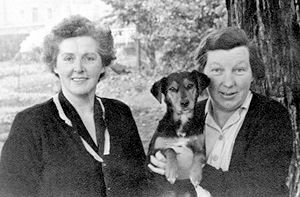 Head Teachers
Head Teachers
The only photo so far found of Head Teachers is shown right with Mrs. Buxton on the left and Mrs. Foulkes-Williams on the right.
The table below shows all the Head Teachers at the school and their periods of office.
Head Teacher |
Period of Office and Notes |
|---|---|
Mr R. Harrison |
Served from the opening of the school in May 1869 until the summer of 1898. He was previously Head Teacher at the school held in the Church and retired with a total of forty three years service, indicating that he first started teaching in the village in 1855. |
Mr G. Craddock |
Served from October 1898 until 1904. |
Mr. L Morgan |
Served from December 1904 until November 1906. |
Mr. T. Hagger |
Came from Ashby de la Zouch and served between December 1906 and October 1926. |
Mr. W.E. Jenkins |
Appointed in November 1926 and left in June 1929 to assume role as Headmaster at Thurmaston School. |
Miss J.B. Davies |
First female Head Teacher, served between June 1929 and February 1937. |
Mrs A. Large |
Appointed April 1937 and died in July 1950. |
Mrs. D.K. Reed |
Appointed temporary Head Teacher from July 1950 until December 1950. |
Mrs. S. Buxton |
Appointed in January 1951 and resigned in December 1952 to go to the United States of America. |
Mrs E. Farmer |
Served between January 1953 and April 1958. |
Miss D. Kisby |
Appointed April 1958, resigned in July 1959 to take a Head Teachers position in Northampton. |
Mrs. W. Foulkes-Williams |
Appointed temporary Head Teacher from July 1959 until December 1959. |
Mr J. Kirton |
Appointed January 1960, resigned in December 1963 to take up a position at a school in Hampshire. |
Mr D. Bradley |
Appointed in January 1964, resigned in July 1968 to take up position as Head Teacher at East Goscote County School. |
Mr D. Staples |
Appointed in August 1968, resigned in March 1972 to assume position of Head Teacher of Ridgeway School, Market Harborough |
Mr. G. Robinson |
Appointed temporary Head Teacher between April 1972 and December 1972. |
Mr M. Shimmin |
Appointed in January 1973, resigned in March 1980 to take up a position as Head Teacher at a school in Norfolk. |
Mrs J Clarke |
Appointed in April 1980 and remained until the school closed in April 1981. |
Page contributed by Keith Sandars, March 2013.
